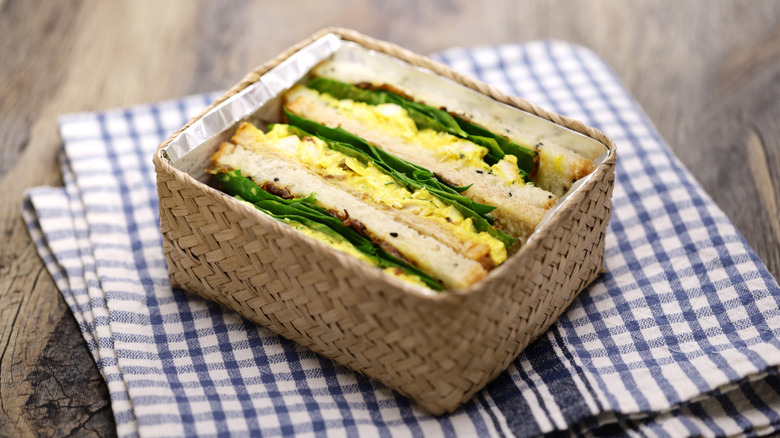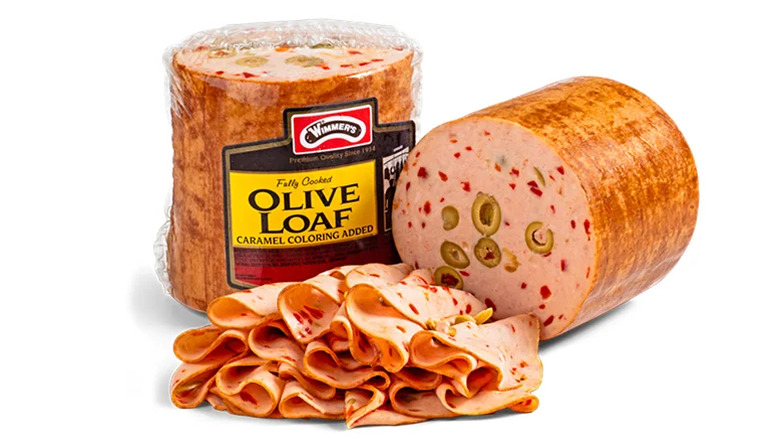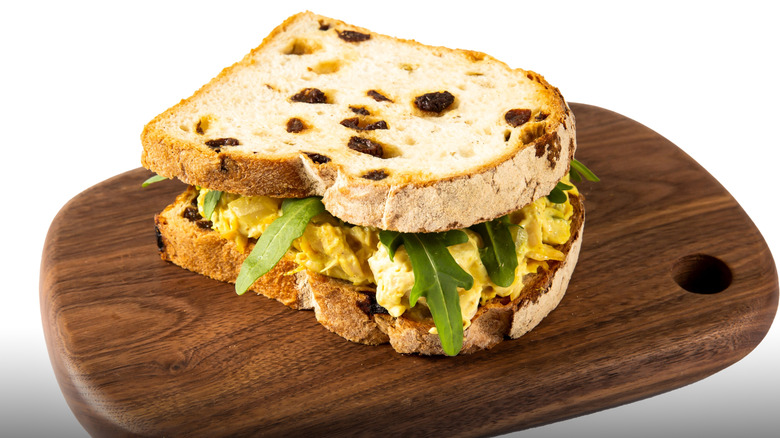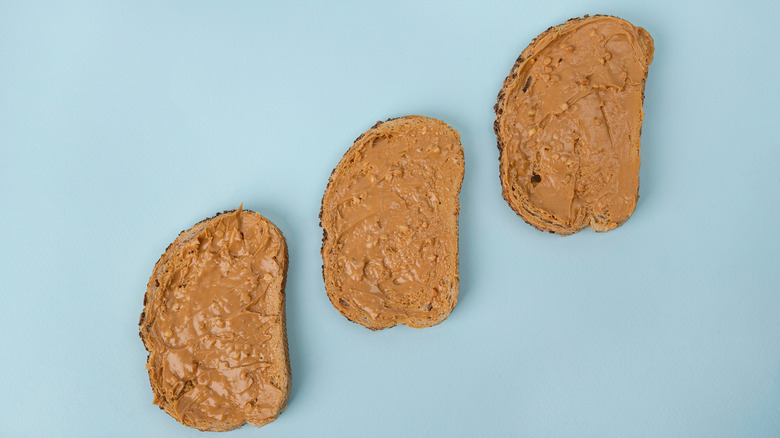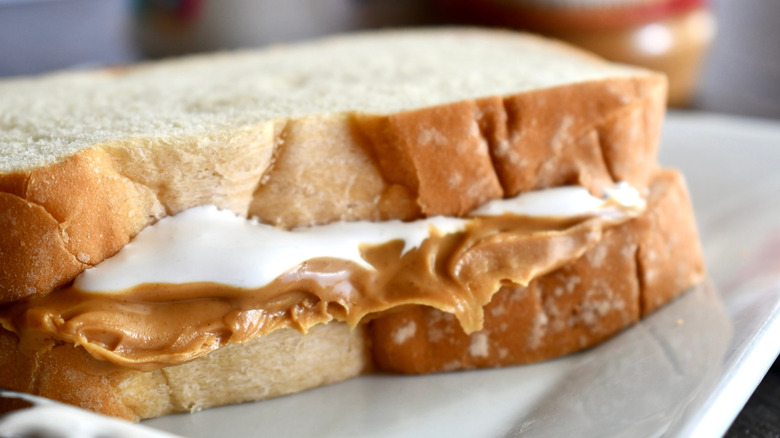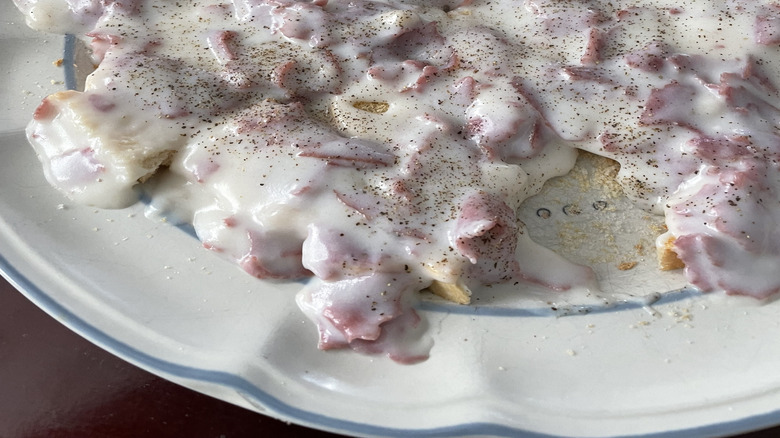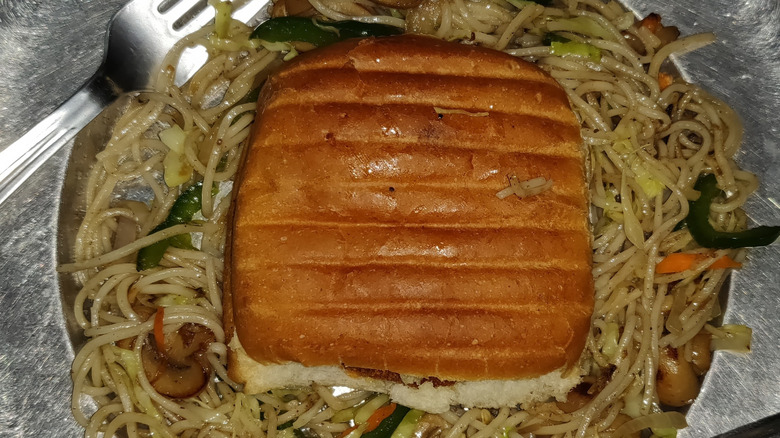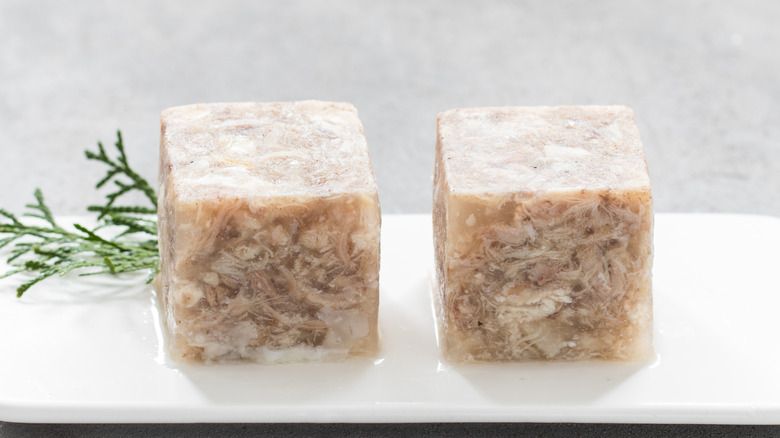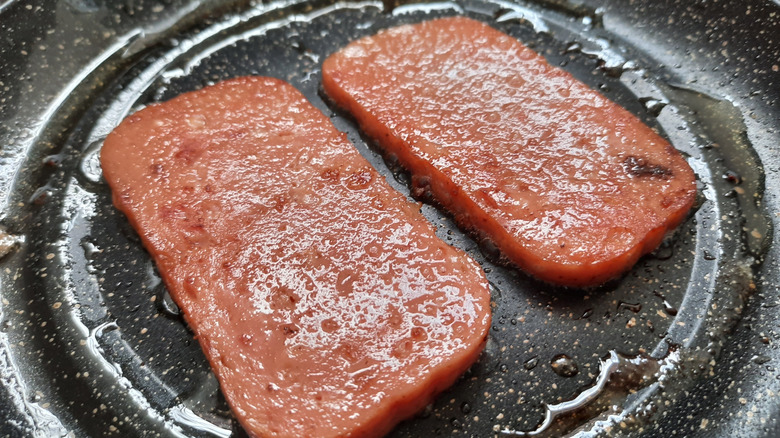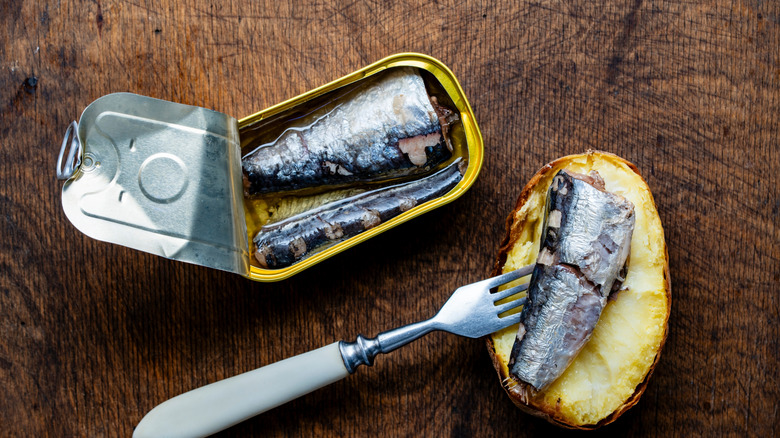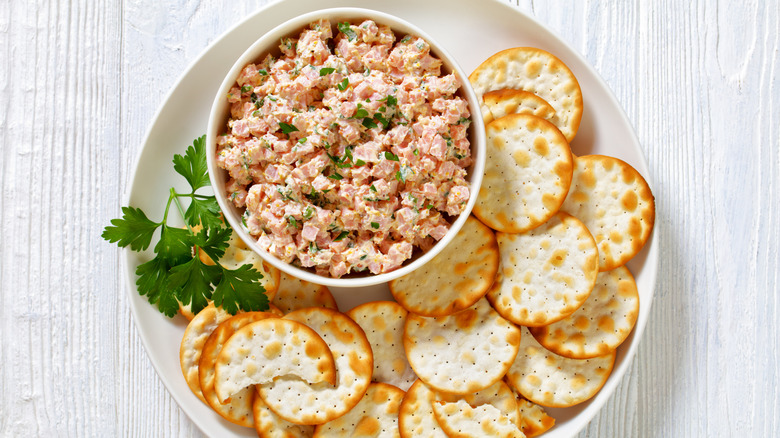Old-School Sandwiches People Rarely Eat Anymore
The sandwich is arguably one of the most versatile meals you can make. Enjoyed for breakfast with eggs as the star protein, lunch with simple cold cuts, or dinner via a colossal burger, this handheld dish has been around for centuries. Though there are historical links to bread and meat being enjoyed as far back as the first century B.C., the sandwich in its current form is credited to having been created by John Montagu (known as the Earl of Sandwich) in England in 1762. The sandwich has a huge following in the U.S. now, but it didn't spike in popularity in the States until the 1900s.
With the long history of people enjoying sandwiches, it's no surprise that some pairings just haven't stood the test of time. Whether it was a cultural or societal shift, ingredient availability, or just the natural evolution of food, you won't find some of the biggest sandwich hits over the decades anymore. Read on to see if some of these creations are worth rehashing in your kitchen or just plain cringeworthy.
Olive loaf sandwich
Though you won't see an olive loaf sandwich at the top of a deli menu list nowadays, it was once a supper staple. My father-in-law described olive loaf sandwiches on white bread as one of his childhood favorites. Olive loaf was such a popular deli order in the 1970s that Oscar Mayer offered it as one of its main lunchmeats. Unsurprisingly, by its name, olive loaf contains pimento-stuffed green olives in a bologna-like finely ground mixture of meats that can include pork, beef, or even chicken. The meat is molded into a square loaf-like shape and thinly sliced to be enjoyed on sandwiches. It would typically be enjoyed on white bread with your cheese and condiment of choice.
Over time, it appears tastes have changed, and olive loaf became less and less popular (possibly due to its heavily processed nature). That doesn't mean that olive loaf doesn't have a place in sandwiches today, though. If you want olive loaf with a little Italian flair, you'll love mortadella. Italian mortadella, a finely ground pork-based sausage similar to olive loaf, can be found on muffuletta sandwiches with other cured meats.
Coronation chicken sandwich
Coronation chicken surged in popularity in the '50s thanks to Le Cordon Bleu London and its chicken dish fit for royalty. Coronation chicken was served for Queen Elizabeth II's Coronation luncheon in 1953. The original dish featured young roasting chickens diced up and a cream of curry sauce served over a salad of rice, peas, and pimentos. The dish made its way over to the United States later in the 1950s as a mainstay for parties. The dish itself took on a more modern flair as a sandwich (Le Cordon Bleu even has a recipe for coronation chicken with brioche buns and crème fraîche). Some modern takes on the coronation chicken started to include seedless grapes, while others pared down the sandwich to chicken, mayonnaise, and curry powder.
You will still find coronation chicken sandwiches served in the United Kingdom delis and in supermarkets, possibly due to its sentimentality. Odds are, you won't find it as a staple menu item at your corner deli in the States or at a dinner party or luncheon.
Peanut butter and mayo sandwich
Peanut butter and mayonnaise are two condiments that can be found on many sandwiches today. But, many of us wouldn't even think of combining the two into one sandwich — and one survey found that most people wouldn't even give it a try. But back in the Great Depression era, the peanut butter and mayonnaise sandwich was a high-calorie meal that didn't use costly ingredients like protein or dairy. After the war ended, the peanut butter and mayonnaise sandwich stuck around in households for a few more decades. You would find the peanut butter and mayo on white bread combination more prevalent in some regions than others. In those regions, the PB&M was just as popular as the PB&J of today.
The sandwich evolved over the years to include other toppings like cheese, bacon, or even pickles. My husband has childhood memories of balking at peanut butter and pickle sandwiches. But if the survey respondents are any indication, peanut butter and mayo sandwiches aren't getting put in kids' lunchboxes these days. It could be because there are more readily available (and affordable) ingredient options, or because establishments are peanut-free. Whatever the reason for the PB&M's demise, it may be worth a try if you find yourself with an empty fridge and a loaf of bread.
Banana and mayo sandwich
Believe it or not, there was another sandwich that used mayonnaise as a main ingredient and not a condiment. The banana and mayonnaise sandwich is believed to be a Depression-era creation popular in the Southern region of the United States. But recipes for sandwiches containing banana and mayonnaise actually appear as far back as 1912, though it is a little different with the addition of spreading cream cheese onto the bread. Though there may be variations of this (some swear by adding peanut butter to the mix), the banana and mayo sandwich experts of the South claim that it has to be white bread, Duke's mayo, and perfectly yellowed bananas. No brown spots and no green underripe bananas are allowed on this sandwich.
Nowadays, you may find more sandwiches sans mayonnaise, like the popular peanut butter and honey paired with sliced bananas. You may get looks when mentioning a banana and mayo sandwich outside of the South, but you could also create the next generation of banana and mayo enthusiasts by introducing it to your culinary circle.
Fluffernutter sandwich
Though this sandwich isn't necessarily known for its high nutritional value, picky eaters or those with a sweet tooth have long enjoyed Fluffernutter sandwiches. The Fluffernutter combines peanut butter and spreadable Marshmallow Fluff for a sticky and sweet sandwich that you could argue is more dessert than entree. This combination was especially popular in New England, with recipe roots back to Massachusetts in 1918, called a "Liberty Sandwich." Whatever you call it, the classic Fluffernutter sandwich is reported to be on white bread and cut into triangles. Some newer variations have the bread toasted, and others add a dash of cinnamon or honey.
If you are in New England, you may find Fluffernutter sandwiches on the lunchtime menu. There may be a certain pride behind the sandwich's origin — the national Marshmallow Fluff brand of spreadable marshmallow is still produced in Massachusetts today. In fact, there is a festival dedicated entirely to Marshmallow Fluff in Somerville, Massachusetts. However, in other regions, Fluffernutter sandwiches may be rarer, possibly due to the rise of other spreadable options like Nutella. Regardless of your geographic location, Fluffernutter sandwiches can be the perfect sweet taste of the past.
Chipped beef on toast
Nicknamed S.O.S. for "sh** on a shingle" by U.S. Army soldiers in the early 1900s, creamed chipped beef on toast was once a popular open-faced sandwich for breakfast. The first "S" is the dried, chipped beef that was cooked in a creamy sauce before being served on a "shingle," aka a slice of toasted bread. The recipe appeared in an Army cookbook in 1910 and continued to be served through World War I and II, the Korean War, and the Vietnam War. The dish eventually evolved from using chipped beef to ground beef or ground turkey as the protein choice.
Though some may enjoy this for nostalgic purposes, you likely aren't packing this for lunch. That's not to say you won't find S.O.S. on a diner menu in certain parts of the country for breakfast, but it doesn't have the same following in civilian life as it once did in the 1950s.
Chow mein sandwich
You have likely seen chow mein as a dish on a Chinese takeout menu. Chow mein is known for its brown sauce, meat (usually pork), and vegetables served over crunchy noodles. But in New England towns like Fall River, Massachusetts, the dish was enjoyed in sandwich form in the early 1900s. This creation married the more traditional Chinese cuisine to what the influx of immigrants working in factories were more familiar with — a sandwich. What resulted is chow mein as the filling with the addition of hamburger buns, making it (in theory) a handheld dish, but utensils are likely needed. The chow mein sandwich was known for its large portion size and low price, making it hugely popular in the mid-20th century. The chow mein sandwich went beyond the factory cafeterias to being served in the local schools and lunch counters throughout the region.
Select restaurants in Fall River and neighboring areas still serve up the chow mein sandwich today. There are even the specific fried chow mein noodles available in New England grocery stores or available online if you are inspired to try it at home. However, chow mein can typically be found on takeout menus as a noodle dish and not in sandwich form outside of New England.
Jellied chicken sandwich
When you think of gelatin, you probably think of the jiggly classic Jell-O dessert molds in vibrant colors. Though gelatin was a mainstay in homes in the '50s and '60s as savory salads or sweet desserts, it was actually used in earlier years for its preserving qualities. The technique of placing food into molds — called aspic — would actually seal the food from oxygen and keep it from spoiling without refrigeration. The jellied chicken sandwich of the early 1900s took a paste made from chopped, boiled chicken and mixed it with gelatin, cream, and horseradish to make chicken salad, but solidified. The recipe was featured in the 1936 book titled "1,001 Sandwiches." If chicken wasn't available, some recipes stated that cooked veal, beef, or lamb could be used.
The end result was a mold with chicken suspended inside that could almost pass for a science experiment. Once solid, the jellied chicken creation was sliced and used for sandwiches with condiments of choice. Safe to say that these days, you probably enjoy chicken salad in its regular salad-like form, minus the gelatin.
Fried Spam sandwich
If you have perused your canned goods aisle at your local grocery store, you likely will see Spam on the shelves still today. The canned pork shoulder and ham meat combination has been around since 1937, thanks to Hormel Foods, which created the inexpensive meat during the Great Depression when protein options were scarce. Spam continued to be a popular choice in households through World War II, with people getting creative with preparation and serving techniques. But one simple way to serve Spam was on a sandwich. In the Depression era, a Spam sandwich was simply Spam on white bread with cheese and mayonnaise. Over time, Spam sandwiches got refreshed with different customizations, like adding pineapple slices for a sweet and salty flavor profile, or using baked beans atop the Spam in the sandwich.
While there are certainly dishes that utilize Spam available today (there have been surges of popularity over the years, especially overseas), the odds of seeing a simple fried Spam sandwich on a lunch menu or whipping it up for your family at home are not as high as they once were. However, Spam does make an appearance on some fine dining menus, as well as the star of dishes like Spam musubi or Spam fried rice.
Egg and sardine sandwich
Eggs and sardines are two food items that you wouldn't necessarily think to pair together at first, like eggs and bacon. But in the 1920s, a sandwich popped up in cookbooks utilizing both ingredients in sandwich form. The hard-boiled eggs were combined with canned sardines and mayonnaise for an egg salad sandwich with an extra omega-3 protein punch on white bread (a common vessel choice for these early 1900s recipes). A 1939 recipe from a New Orleans chef showcased a sardine and egg sandwich in a whole section dedicated to luncheon and tea-time sandwiches.
Why sardines and eggs were combined into the egg and sardine sandwich in the first place is up for debate. It could be a personal palate preference leaning toward salty over sweet, or an economical way to make the sandwich filling go a little farther by adding in two protein options. An egg salad sandwich is certainly still one you can find at many delis or make yourself right at home with simple ingredients you likely have in your fridge. But sardines are likely not a mainstream ingredient in sandwiches today.
Ham salad sandwich
If you ever had leftover ham to use up, this sandwich was likely in your repertoire. But the ham salad sandwich origins go farther back to the Depression era as an affordable way to ration ham, as its preparation allows you to use up all excess ham trimmings. In the mid-20th century, you would find ham salad brought to potlucks, funerals, and luncheons, as it feeds a lot of people with less protein than a cold-cut sandwich. Some have even called ham salad synonymous with funerals because it was a dish you could count on seeing at the post-funeral luncheon. The ham salad sandwich was traditionally served on white bread, but could also be spread on crackers or biscuits. There was even a "Mock Ham Salad Sandwich" that utilized bologna instead of ham during World War II.
In more recent times, hot casserole dishes seemed to surpass the ham salad sandwich as more popular for feeding larger crowds. But if you are in the Southern or Midwestern part of the United States, you could still find prepared ham salad sandwiches on restaurant menus or premade in delis. You are also more likely to run into a ham salad sandwich on the luncheon circuit in these regions.
Tartar sandwich
The name of this sandwich is a little misleading, as it does not have a tartar sauce base. It also isn't the preparation of raw meat "tartare" with an "e." The tartar sandwich recipe appeared in a 1940s cookbook by Keen's mustard, and required powdered mustard, water, sardines, diced ham, pickles, and lemon juice. The tangy combination was put on slices of white bread or buttered toast. Other variations of a tartar sandwich added ketchup, lettuce, bacon, and mayonnaise to the sardine, mustard, ham, and pickle mixture.
Whatever toppings you selected for a tartar sandwich, it can be assumed this sandwich preparation is not one to expect at a restaurant or deli. If for no other reason, the confusion about the name could be problematic to its popularity. If you order a tartar sandwich at a deli counter, you may get some funny looks as if you wanted a sandwich made up of just tartar sauce, or an upscale preparation of steak tartare.
